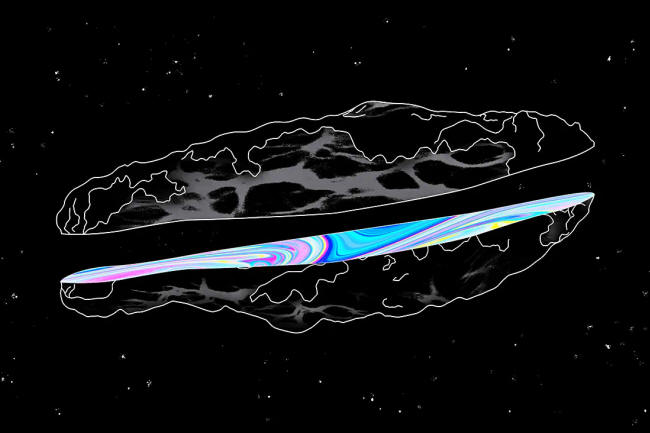|
Jason
Arias/Quanta Magazine
At closest approach, it was moving at a speed of 54 miles per second relative to the Sun, traversing in one second the distance that a typical car crosses on the highway in one hour
At that speed, 'Oumuamua was not bound by the Sun's gravity and was heading out of the Solar system.
The brightness of sunlight reflected from its surface changed by a factor of ten as it was tumbling every 8 hours, suggesting a shape that is disk-like at the 91% confidence (Modelling the light curve of 'Oumuamua - Evidence for torque and disc-like shape).
Moreover, 'Oumuamua exhibited non-gravitational acceleration away from the Sun without any visible signs of a cometary tail.
The level of that acceleration, 0.1% of the gravitational acceleration induced by the Sun, required that the object lose about a tenth of its mass through standard cometary evaporation in order for it to obtain the observed push from the rocket effect.
Such a high level of evaporation would have been easily observed in the form of a familiar cometary tail that reflects sunlight.
However, no carbon-based molecules or dust particles were spotted around 'Oumuamua following deep observations by the Spitzer space telescope (Spitzer Observations of Interstellar Object 1I/'Oumuamua).
By now, 'Oumuamua is 44 times farther than the Earth is from the Sun and 100 million times fainter than it was close to Earth.
Last night, I gave a public lecture to an inspiring women's organization near the Harvard College Observatory in Cambridge Massachusetts.
While discussing 'Oumuamua, I pointed out the analogy with a memorable dating experience.
Just as in an intriguing encounter with someone who left the bar to the dark street before we could get enough information from them, we can search for past encounters with their family members in order to gain more information about their origins.
One of the attendees asked:
This was late last night...
As soon as I woke up this morning, I did the
related calculation before my morning jog at sunrise.
Adopting this abundance and the local speed of 'Oumuamua, I calculated that there should have been a few impacts by 'Oumuamua's family members on the Moon during its 4.5 billion years history.
Can we identify the craters they left behind?
Based on a recent census, there are at least,
This large number of scars on the face of the
Moon is not surprising since the abundance of 'Oumuamua-size rocks
from the Solar system that are flying around the Earth is about of
order a thousand times larger than those originating from
interstellar space.
Since the surface area of the Earth is 13.4 times larger than that of the Moon, there were probably tens of related impacts on Earth but their craters were compromised by pre-impact ablation in the Earth's atmosphere and post-impact geological activity over hundreds of millions of years.
Given a thousand times more impactors from the Solar system,
A better way to proceed is to search for 'Oumuamua's family members as they pass near Earth without colliding, just as 'Oumuamua did.
Starting in 2025,
After all, there are many more fish in the
interstellar ocean than those captured by our fishing nets.
|


